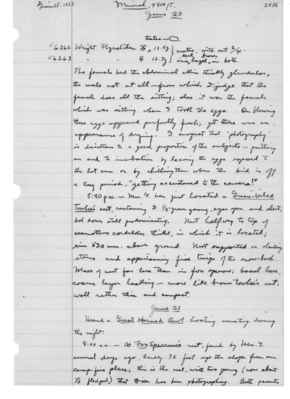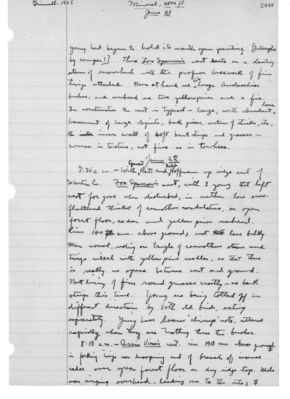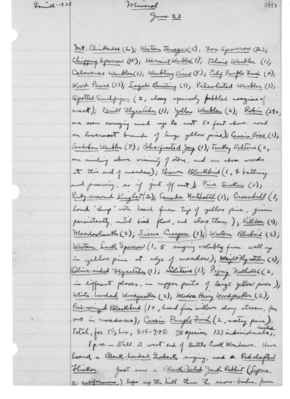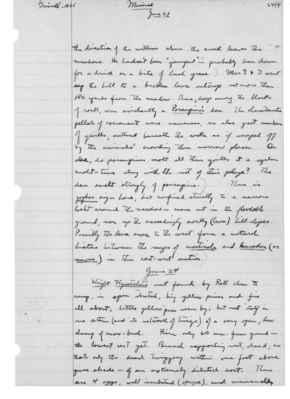Pages That Mention snow bush
1925: Joseph Grinnell's field notes
S2 Page 31
Collector: Grinnell-1925 Location: Mineral, 4800 ft., Date: June 20 Page Number: 2486
6262 Wright Flycatcher (male) ^testes [illustration] 12.5 g 6263 [Wright] [Flycatcher] (female) 12.7 g } mates, with set 2/4. iris ^dark hazel ^brown in both.
The female had the abdominal skin thickly glandular, the male not at all - from which I judge that the female does all the sitting; also it was the female which was sitting when I took the eggs. On blowing these eggs appeared perfectly fresh; yet there was an appearance of drying. I suspect that "photography" is disastrous to a good proportion of the subjects - putting an end to incubation by leaving the eggs exposed to the hot sun or by chilling them when the bird is off a long period, "getting accustomed to the camera!"
5:40 p.m. - Mrs. G. has just located a Green-tailed Towhee's nest, containing 3 1/3-grown young, eyes open and alert, but down still predominating. Nest halfway to top of ceanothus cordulatus thicket, in which it is located; rim 520 mm. above ground. Nest supported on slanting stems and appertaining fine twigs of the snow-bush. Mass of nest far less than in fox sparrow; basal loose, coarse layer lacking - more like brown towhee's nest; wall rather thin and compact.
June 21 Heard a Great Horned Owl hooting something during the night.
8:00 a.m. - At Fox Sparrow's nest, found by Mrs. G. several days ago, hardly 75 feet up the slope from our camp-fire place; this is the nest, with two young (now about 1/3 fledged) that Dixon had been photographing. Both parents
S2 Page 33
Collector: Grinnell-1925 Location: Mineral, 4800 ft. Date: June 21 Page Number: 2488
young had begun to hold its mouth open pouting. [Interrupted by camper!] This Fox Sparrow's nest rests on a slanting stem of snow-bush with the proper lacework of fine twigs attached. Near at hand are two large Amelanchier bushes; and overhead are two yellow pines and a fir. In construction the nest is typical - large, with abundant loose basement of large objects, bark pieces, section of sticks, etc., the inner wall of soft bark strips and grasses course in texture, not fine as in towhees.
June 22 7:34 a.m. - With ^Egmont Rett and ^Ralph Hoffmann up ridge east of Martin Cr. Fox Sparrow's nest, with 3 young that left nest for good when disturbed, in rather low snow flattened thicket of ceanothus cordulatus, on open forest floor, cedar and yellow pines overhead. Rim 140 ft mm. above ground; nest last less bulky than usual, resting on tangle of ceanothus stems and twigs mixed with yellow pine needles, so that there is really no open space between nest and ground. Nest lining of fine round grasses mostly - no bark strips this time. Young are being lolled (?) off in different direction by both old birds, acting separately. Young have hoarse "chirrup" note, uttered rapidly when they are trotting thru the bushes.
8:15 a.m. - Cassin Vireo's nest: rim 1910 mm. above ground in forking twigs near drooping end of branch of incense cedar over open forest floor on dry ridge top. Male was singing overhead, leading me to the site; [female symbol]
S2 Page 37
Collector: Grinnell - 1925 Location: Mineral Date: June 22 Page Number: 2491
Wright Flycatcher's nest, near camp (75 ft. uphill from), with 4 young hatched on 14th; found with opaque eggs two days previously by Dixon and, I think, photographed by him. Rim of nest 1500 mm. above ground, nest (of usual construction and gray color, ensconced among pendent twigs were [sic] a slender branch from each of two adjacent red cherry bushes one another, and one of these has an unhealthy outgrowth of leafage looking like mistletoe. Nest within to feet, one east side, of 24-inch trunk of yellow pine; snow bushes nearby, and firs within 20 feet; site practically where a tract of timber and a hillside tract of open snowbush adjoins. Male fed young at 3:12 and 3:16, he not being, apparently, alarmed at us, as is female which was brooding when we came. Female continues to utter a faint "peet" of concern; male from overhead says "see-put" (uttered very rapidly); when male alighted on edge of nest to feed, he gave a short musical trill of short duration and weak in volume. Female keeps close to nest, perching on twigs within a radius of 4 feet. She perches on edge of nest; leaves; returns and settles down to brood, continuing to say "peet", but more faintly. 3:30 - [female symbol] still brooding and saying "peet" very faintly and not so frequently. 3:35 - (female) still brooding, tho nest is in shade of pine trunk: has ceased to say "pit."
S2 Page 39
Collector: Grinnell - 1925 Location: Mineral Date: June 23 Page Number: 2493
Mt. Chickadee (2); Western Tanager (5); Fox Sparrow (2); Chipping Sparrow (18); Hermit Warbler (3); Tolmie Warbler (1); Calaveras Warbler (1); Warbling Vireo (8); Calif. Purple Finch (4); Wood Pewee (13); Lazuli Bunting (3) Pileated Warbler (1); Spotted Sandpiper (2, along sparsely pebbled margins of creek); Traill Flycatcher (1); Yellow Warbler (2); Robin (29+, one seen carrying mud up to nest 50 feet above and on lowermost branch of huge yellow pine); Cassin Vireo (1); Audubon Warbler (7); Blue-fronted Jay (1); Turkey Vulture (2, one circling above vicinity of store (?), and one above woods at this end of the meadow) Brewer Blackbird (1, [female symbol] bathing and preening, as if just off nest); Pine Siskin (1); Ruby-crowned Kinglet (2); Canada Nuthatch (1); Crossbill (1, loud "chup" note heard from tips of yellow pine, given persistently, until bird flew, and also then); Killdeer (2); Meadowlark (2); Sierra Creeper (1); Western Bluebird (2); Western Lark Sparrow (1, [male symbol] singing volubly from well up in yellow pine at edge of meadow); Wright Flycatcher (2); Olive-sided Flycatcher (1); Solitaire (1); Pygmy Nuthatch (2, in different places, in upper parts of large yellow pines); White-headed Woodpecker (2); Modoc Hairy Woodpecker (2); Red-winged Blackbird (1+, heard from willows along stream, far out in meadows); Cassin Purple Finch (2, mating pair).
Total, for 1 1/2 hrs., 8:15-9:45: 38 species, 133 individuals.
1 p.m. Still at west end of Battle Creek Meadows. Have heard a Black-headed Grosbeak singing, and a Red-shafted Flicker. Just saw a Black-tailed Jack Rabbit (Lepus c. californicus) lope up the hill thru the snow bushes, from
S2 Page 40
Collector: Grinnell - 1925 Location: Mineral Date: June 23-24 Page Number: 2494
the direction of the willows where the creek leaves the meadows. He hadn't been "jumped" - probably been down for a drink or a bit of lush grass. Mrs. G. & I went up the hill to a broken lava outcrop not more than 150 yards from the meadow. There, deep among the blocks of rock, was evidently a Porcupine's den. The characteristic pellets of excrement were numerous, as also great numbers of quills, scattered beneath the rocks as if scraped off by the animals' crowding the narrow place. Or else, do porcupines molt all their quills at a regular molt-time along with the rest of their pelage? The den smelt strongly of porcupine. There is gopher sign here, but confined strictly to a narrow belt around the meadow - none out in the floodable ground, nor up in the exceedingly rocky (lava) hill-slopes. Possible the lava areas to the west form a natural hiatus between the ranges of monticola and leucodon (or navus) in this east-west section.
June 24 Wright Flycatcher's nest found by Rett close to camp, in open stretch, big yellow pines and firs all about; little yellow pines near by; but nest itself in one stem (and its network of twigs) of a very open, low clump of snow-bush. Rim only 6/0 mm. from ground the lowest nest yet. Branch supporting nest, dead; so that only the dead twiggery within one foot above gives shade - of an extremely diluted sort. There are 4 eggs, well incubated (opaque), and unusually




